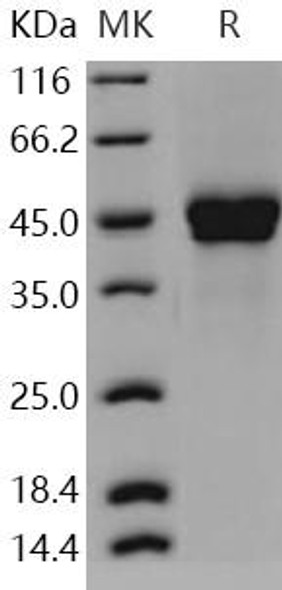Description
| Product Name: | Recombinant Human Pentraxin 3/TSG-14 Protein (His Tag) |
| SKU: | RPES8387 |
| Size: | 20μg |
| Tag: | C-His |
| Reactivity: | Human |
| Expression Host: | Mammalian |
| Accession: | P26022 |
| Sequence: | Glu18-Ser381 |
| Calculated Molecular Weight: | 39.9 kDa |
| Observed Molecular Weight: | 45 kDa |
| Synonyms: | PTX, Pentraxin, TNFAIP, PTX3/TSG, TSG, PTX3, TNFAIP5, TSG-14, long, Pentraxin 3, PTX3/TSG-14, TNF-inducible gene 14 protein, TSG14, AI607804, long, TNF-inducible gene 14 protein, Pentaxin 3, Pentaxin-related protein PTX3, Pentraxin 3 long, Pentraxin-related gene, Pentraxin-related gene rapidly induced by IL-1 beta, Pentraxin-related protein PTX3, TNF alpha-induced protein 5, TSG-14, Pentraxin 3, Tumor necrosis factor alpha-induced protein 5, Tumor necrosis factor-inducible gene 14 protein, Tumor necrosis factor-inducible protein TSG-14 |
| Endotoxin: | < 1.0 EU/mg of the protein as determined by the LAL method |
| Purity: | > 90% as determined by reducing SDS-PAGE. |
Pentraxin-related protein PTX3, also known as Tumor necrosis factor alpha-induced protein 5, Tumor necrosis factor-inducible gene 14 protein, TSG-14, PTX3 and TNFAIP5, is a secreted protein that contains one pentaxin domain. PTX3 plays a role in the regulation of innate resistance to pathogens, inflammatory reactions, possibly clearance of self-components and female fertility. Pentraxins are a family of evolutionarily conserved multifunctional pattern-recognition proteins characterized by a cyclic multimeric structure. Based on the primary structure of the subunit, the pentraxins are divided into two groups: short pentraxins and long pentraxins. C-reactive protein (CRP) and serum amyloid P-component (SAP) are the two short pentraxins. The prototype protein of the long pentraxin group is pentraxin 3 (PTX3). CRP and SAP are produced primarily in the liver in response to IL-6, while PTX3 is produced by a variety of tissues and cells and in particular by innate immunity cells in response to proinflammatory signals and Toll-like receptor (TLR) engagement. PTX3 is essential in female fertility by acting as a nodal point for the assembly of the cumulus oophorus hyaluronan-rich extracellular matrix. PTX3 interacts with several ligands, including growth factors, extracellular matrix components and selected pathogens, playing a role in complement activation and facilitating pathogen recognition by phagocytes, acting as a predecessor of antibodies. PTX3 may also contribute to the pathogenesis of atherosclerosis.
| Bio-activity: | Not validated for activity |
| Formulation: | Lyophilized from a 0.2 μm filtered solution in PBS with 5% Trehalose and 5% Mannitol. |
| Reconstitution: | It is recommended that sterile water be added to the vial to prepare a stock solution of 0.5 mg/mL. Concentration is measured by UV-Vis. |
| Storage: | Generally, lyophilized proteins are stable for up to 12 months when stored at -20 to -80℃. Reconstituted protein solution can be stored at 4-8℃ for 2-7 days. Aliquots of reconstituted samples are stable at < -20℃ for 3 months. |
| Shipping: | This product is provided as lyophilized powder which is shipped with ice packs. |






